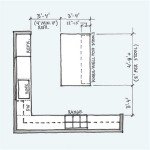What Is Standard Kitchen Sink Size?
The size of a kitchen sink is a crucial consideration when planning a kitchen remodel or building a new home. Choosing the right size sink can greatly impact the functionality and aesthetics of your kitchen. While there isn't one definitive "standard" size, there are common dimensions and guidelines to help you determine the best option for your needs. This article delves into the essential factors that influence kitchen sink size and provides a comprehensive overview of standard dimensions and their implications.
Factors Determining Kitchen Sink Size
Several factors influence the ideal size of a kitchen sink for your kitchen. These include:
- Kitchen layout and counter space: The size of your kitchen and the amount of counter space available will influence the size of sink that fits comfortably.
- Number of people using the kitchen: A larger family may require a bigger double-bowl sink to accommodate multiple dishes and cooking demands.
- Cooking style and frequency: If you frequently cook large meals or entertain guests, a larger sink with ample space will be more convenient.
- Type of sink desired: Single-bowl, double-bowl, farmhouse, or undermount sinks each have their own dimensions and impact on overall kitchen design.
Standard Kitchen Sink Dimensions
Standard kitchen sink sizes generally fall within the following ranges, but variations exist based on brand and style. It's crucial to consult specific product specifications for exact measurements.
Single Bowl Sinks
- Small: 25 to 30 inches wide
- Medium: 30 to 33 inches wide
- Large: 33 to 36 inches wide
Single-bowl sinks are commonly found in smaller kitchens or kitchens with limited counter space. They offer a large, uninterrupted surface for washing dishes, soaking items, or filling pots and pans. However, they lack the versatility of double-bowl sinks.
Double Bowl Sinks
- Small: 25 to 30 inches wide with two equal-sized bowls
- Medium: 30 to 33 inches wide with two equal-sized bowls
- Large: 33 to 36 inches wide with two unequal-sized bowls, with one often being significantly larger than the other.
Double-bowl sinks provide separation for washing and rinsing, making them ideal for busy kitchens. They also offer a larger surface area for preparing food and washing dishes. The size of each bowl can vary, with some having equal-sized bowls and others featuring an oversized main bowl and a smaller prep bowl.
Considerations When Choosing Sink Size
Beyond the standard dimensions, various other factors influence your sink size choice:
- Depth: Sink depth significantly affects usability. Deeper sinks provide more space for washing large pots and pans, but they can be harder to reach into. Standard depths range from 8 to 10 inches.
- Installation Type: Undermount, top-mount, and farmhouse sinks each have distinct installation methods and affect the overall countertop design. Consider these factors when selecting a sink size.
- Material: Different sink materials, like stainless steel, cast iron, or composite, may have varying thicknesses and impact the overall sink dimensions.
By carefully considering the factors above, you can choose the ideal kitchen sink size that meets your functional and aesthetic needs.

A Simple Guide To The Kitchen Sink Size Chica Dragon
Kitchen Sink Buying Guide Signature Hardware

Raviv Stainless Steel 33 In Single Bowl Drop Kitchen Sink

Everything You Want To Know About Standard Kitchen Sink Sizes Nirali Ng

American Standard 18db6311800s 075 Stainless Steel Portsmouth 32 1 4 Drop In Double Basin Kitchen Sink With Basket Strainer Faucetdirect Com

American Standard Portsmouth Undermount 18 5 In X 32 25 Stainless Steel Double Equal Bowl Kitchen Sink 18db6311800s 075 At Lowes Com
What Are The Most Common Sink Sizes Vevano

Dimension Of Kitchen Sink Standard Sizes In Best Products

Ultimate Guide To Kitchen Sink Size

Standard Kitchen Sink Size Design Ideas Images Check More At Http Www Entropiads Com
See Also








